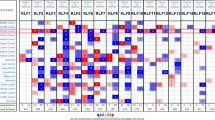Abstract
Purpose
Krüppel-like factor 5 (KLF5) is a zinc finger transcription factor, which has recently attracted attention because of its important regulatory activities linked to diverse functions such as cell growth, proliferation, differentiation, and tumorigenesis in a number of systems. However, its expression in human gastric cancer has not been described previously. In this study, we investigated the expression profile of KLF5 and the relationship between its clinicopathologic features and expression in gastric carcinomas.
Methods
Tissues were obtained from 247 gastric carcinoma patients who underwent curative gastrectomy (R0 resection) at the Department of Surgery, Seoul National University Hospital from January 1995 to June 1995, and these tissues were arranged in tissue array blocks. KLF5 expression was analyzed by immunohistochemical staining using anti-BTEB2 mouse monoclonal antibodies (Santa Cruz Biotechnology Inc., Santa Cruz, CA, USA).
Results
Overall KLF5 was found to be expressed in 45.7% (113/247) of tumor tissues. Moreover, its expression rate was significantly high in early-staged gastric cancer (63.2 vs. 38.0%, p < 0.001), in gastric cancer without lymph node metastasis (54.0 vs. 40.1%, p = 0.04), and in tumors <5 cm in size (53.0 vs. 38.1%, p = 0.02). The 5-year survival rate of patients with KLF5-positive tumors was higher than those of patients with KLF5-negative tumors, although this was not statistically significant (74.7 vs. 62.2%, p = 0.057).
Conclusion
KLF5 expression rate was high in early-staged gastric cancer, in small gastric cancer tissues and in gastric cancer without lymph node metastasis. By univariate analysis, its expression was found to favor survival after surgery. Our study describes for the first time the expression profile of KLF5 in a large number of human gastric cancer tissues and suggests consistent results shown in many recent studies that reduction of KLF5 expression occurs in many types of human tumor.


Similar content being viewed by others
References
Bateman NM, Tan D, Pestell RG, Black JD, Balck AR (2004) Intestinal tumor progression is associated with altered function of KLF5. J Biol Chem 279:12093–12101
Black AR, Black JD, Azizkhan-Clifford J (2001) Sp1 and Krüppel-like factor family of transcription factors in cell growth regulation and cancer. J Cell Physiol 188(2):143–160
Bloethner S, Chen B, Hemminki K, Muller-Berghaus J, Ugurel S, Schadendorf D, Kumar R (2005) Effect of common B-RAF and N-RAS mutations on global gene expression in melanoma cell lines. Carcinogenesis 26(7):1224–1232
Chanchevalap S, Nandan MO, Merlin D, Yang VW (2004) All-trans retinoic acid inhibits proliferation of intestinal epithelial cells by inhibiting expression of the gene encoding Krüppel-like factor 5. FEBS Lett 578:99–105
Chen C, Bhalala HV, Qiao H, Dong JT (2002) A possible tumor suppressor role of the KLF5 transcription factor in human breast cancer. Oncogene 20:6567–6572
Chen C, Bhalala HV, Vessella RL, Dong JT (2003) KLF5 is frequently deleted and down-regulated but rarely mutated in prostate cancer. Prostate 22:81–88
Chen C, Zhou Y, Zhou Z, Sun X, Otto KB, Uht RM, Dong JT (2004) Regulation of KLF5 involves the Sp1 transcription factor in human epithelial cells. Gene 330:133–142
Chen C, Sun X, Ran Q, Wilkinson KD, Murphy TJ, Simons JW, Dong JT (2005) Ubiquitin-proteasome degradation of KLF5 transcription factor in cancer and untransformed epithelial cells. Oncogene 24(20):3319–3327
Conkright MD, Wani MA, Anderson KP, Lingrel JB (1999) A gene encoding an intestinal-enriched member of the Krüppel-like factor family expressed in intestinal epithelial cells. Nucleic Acids Res 27:1263–1270
Dang DT, Pevsner J, Yang VW (2000) The biology of the mammalian Krüppel-like family of transcription factors. Int J Biochem Cell Biol 32:1103–1121
Dang DT, Zhao W, Mahatan CS, Geiman DE, Yang VW (2002) Opposing effects of Krüppel-like factor 4 (gut-enriched Krüppel-like factor) and Krüppel-like factor 5 (intestinal-enriched Krüppel-like factor) on the promoter of the Krüppel-like factor 4 gene. Nucleic Acids Res 30(13):2736–2741
Hasino Y, Kurabayashi M, Kanda T, Hasegawa A, Sakamoto H, Okamoto E, Kowase K, Watanabe N, Manabe I, Suzuki T, Nakano A, Takase S, Wilcox JN, Nagai R (2000) Regulated expression of the BTEB2 transcription factor in vascular smooth muscle cells: analysis of developmental and pathological expression profiles shows implications as a predictive factor for restenosis. Circulation 102:2528–2534
Kaczynski J, Cook T, Urrutia R (2003) Sp1- and Krüppel-like transcription factors. Genome Biol 4(2):206
Ohnishi S, Laub F, Matsumoto N, Asaka M, Ramirez F, Yoshida T, Terada M (2000) Developmental expression of the mouse gene coding for the Krüppel-like transcription factor KLF5. Dev Dyn 207:421–429
Philipsen S, Suske G (1999) A tale of three fingers: the family of mammalian Sp/XKLF transcription factors. Nucleic Acids Res 27:2991–3000
Shi H, Zhang Z, Wang X, Liu S, Teng CT (1999) Isolation and characterization of a gene encoding human Krüppel-like factor 5 (IKLF): binding to the CAAT/GT box of the mouse lactoferrin gene promoter. Nucleic Acids Res 27(24):4807–4815
Simmen RC, Simmen FA (2002) Progesterone receptors and Sp/Krüppel-like family members in the uterine endometrium. Front Biosci 7:1556–1565
Sogawa K, Imataka H, Yamasaki Y, Kusume H, Abe H, Fujii-Kuriyama Y (1993) cDNA cloning and transcriptional properties of a novel GC box-binding protein, BTEB2. Nucleic Acids Res 21:1527–1532
Sun R, Chen X, Yang VW (2001) Intestinal-enriched Krüppel-like factor (Krüppel-like factor 5) is a positive regulator of cellular proliferation. J Biol Chem 276:6897–6900
Tong D, Czerwenka K, Heinze G, Ryffel M, Schuster E, Witt A, Leodolter S, Zeillinger R (2006) Expression of KLF5 is a prognostic factor for disease-free survival and overall survival in patients with breast cancer. Clin Cancer Res 12(8):2442–2448
Turner J, Crossley M (1999) Mammalian Krüppel-like transcription factors: more than just a pretty finger. Trends Biochem Sci 24:236–240
Acknowledgments
This study was supported by a grant from the Ministry of Science and Technology, South Korea and the Seoul National University College of Medicine Research Fund 2005.
Author information
Authors and Affiliations
Corresponding author
Rights and permissions
About this article
Cite this article
Kwak, M.K., Lee, HJ., Hur, K. et al. Expression of Krüppel-like factor 5 in human gastric carcinomas. J Cancer Res Clin Oncol 134, 163–167 (2008). https://doi.org/10.1007/s00432-007-0265-2
Received:
Accepted:
Published:
Issue Date:
DOI: https://doi.org/10.1007/s00432-007-0265-2




